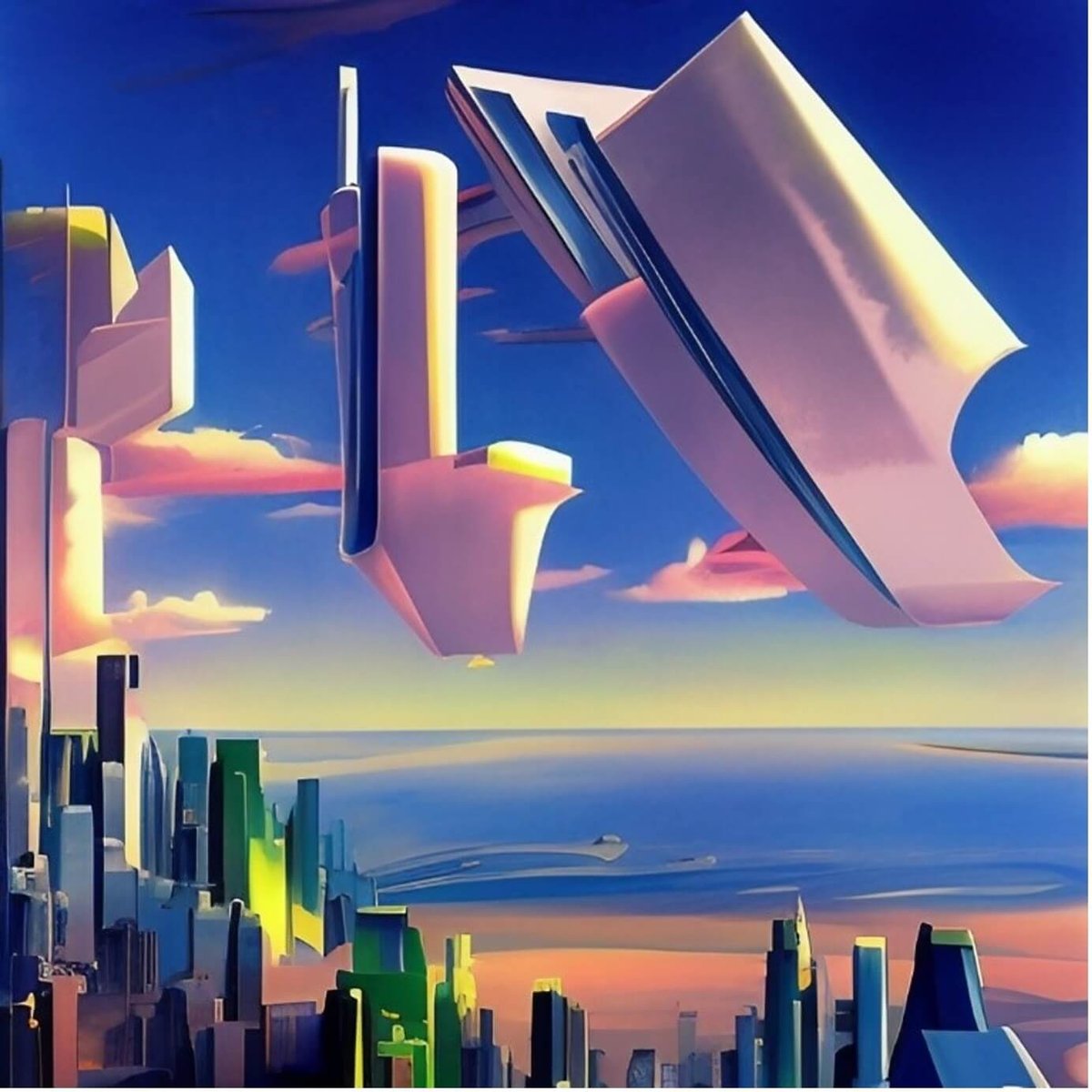I don’t own a crystal ball. Maybe I should purchase one, but I’m waiting for one that comes with a warranty and at least 99.9% accuracy…
In the meantime, I’m very happy to share with you my guesses on the upcoming technology trends for the year through this series. Hopefully, I won’t be too far off.
It’s impossible to list all the things that might happen in the coming 12 months, but I’ll be doing my best to talk about the major points. Keep an eye out for the rest of the Tech Trends 2023 series: Web3, Enterprise, Data, Development & Infrastructure, and a few other technologies we think we should follow. Enjoy!
Note: All pictures are AI generated with Jasper Art.
Blockchain changes will be all about compliance

2023 is shaping up to be a key year for Web3 and blockchain compliance. After the tumultuous fallout of multiple blockchain exchanges, it's clear that existing methods of financial compliance are no longer enough. Web3 protocols, exchanges and users must now pay closer attention to their obligations in the interest of consumer protection.
Companies should expect stringent regulatory measures including anti-money laundering (AML), know-your-customer (KYC) policies, and travel rules, with regular audits and scrutiny by governing bodies.
Expect more regulations and risk management
The shift toward more thorough compliance means Web3 businesses must strengthen their infrastructure and build better systems for collecting, storing, and exchanging consumer data securely. Simultaneously, they will need to identify ways that allow consumers to maintain some degree of privacy while remaining compliant with new regulations.
Multiple ideas have been provided to do so algorithmically. However, every jurisdiction will likely apply new rules and regulations to be followed.
Risk evaluation for trading activities, risky actors, assets (both fungible and non-fungible) custody, moving trading activities in a separate entity, compliance checks, and monitoring tools are quickly becoming essential components of Web3 platforms as users seek to adhere to all local financial regulations. Compliance is no longer an afterthought – it's paramount for Web3 protocols and exchanges, which must stay ahead of the ever-changing landscape to remain successful.
Prepare for more blockchain regulations
Like other financial institutions, it’s expected that blockchain companies will be asked to properly evaluate financial risk (including counterparty risk, asset risk, long-term exposure, etc.). As assets diversify and public adoption increases, the number of defaults will likely increase, and they need a way to handle that. This may be a role that existing financial institutions would be interested in – they already have these kinds of controls and risk systems in place and could modify them to handle cryptocurrencies and digital assets. Whether they provide this service (and advice) to Web3 companies or add a Web3 service to their portfolio, they may have a bigger role to play in the future.
Blockchain is also coming under deep scrutiny from tax agencies worldwide for a lot of different reasons. The most common being gains on cryptocurrencies, of course, but also declared losses and depreciating assets. New tax regulations for blockchain are to be expected in the coming months.
A change of interest calculation for certain stablecoins
Finally, the inconsistencies of interest on blockchain deposits. Some currencies pay interest, some do not. This leads to issues in certain cases, and certainly more now that interest rates are growing. For instance, certain fiat-backed currencies (e.g. certain CBDC) are not providing any direct interest, while their underlying fiat does. This can lead to issues where the actual owner of the money does not see their money's work. Other collateralized stablecoins (Tether, USDC, etc.) propose interest rates way above what’s actually sustainable, and decorrelated from their collateral.
In 2023, we’re expecting some changes in that area, with jurisdictions enforcing rules on interest rates for coin holders.
2023 promises to be a critical year for Web3 compliance. Companies should stay abreast of the changing regulations, so they can better prepare themselves for the future. The success of Web3 companies hinges on their ability to stay compliant and protect consumers.
Less cryptocurrency, more blockchain

High volatility, high risk, added compliance, tax implications: cryptocurrency trading may decline in 2023. But blockchain technology is still going strong. Blockchain use cases, such as non-fungible tokens (NFTs) and smart contracts, make certain asset types that were historically difficult to reach for the public more accessible to a broader audience. In turn, it increases its adoption and stability.
With easier access and less volatility and risk associated with products tokenised on blockchain, more people may be inclined to invest in them – regardless of their prior knowledge or experience.
As blockchain networks become ever more democratised, we are likely to see an even greater demand for blockchain-based solutions. This means that the technology will continue to evolve and grow and is unlikely to look like it does today.
Anticipate new use cases for blockchain
In 2023, we will be seeing several interesting use cases appear. For instance, the tokenisation and trading of assets for carbon credits which includes a royalty clause. The clause ensures that the original producer (e.g. the person planting mangroves) receives a part of the traded value, regardless of the number of intermediaries. Other examples include easy access to crowdlending for impact projects and a way to do micro-financing.
We expect this trend across blockchain projects – a strong focus on reducing the entry barrier for certain activities, and bringing creative, impactful financial solutions – to continue in 2023.
Decentralised infrastructures (beyond blockchain)

Within Palo IT, we've had a strong interest in distributed systems. This includes applications utilising blockchain technology – such as our exploration of Self-Sovereign Identity and the proof-of-concept of our Zero-Code Solidity generator – but also distributed systems in other contexts – such as distributed e-commerce, the Fediverse, and Mastodon.
The "Decentralised Revolution" is here, and it's more than just blockchain. The Fediverse, of which Mastodon is its best-known member, is introducing a new kind of infrastructure that takes decentralisation beyond the chains.
Improved integrity and availability of digital communication
It's an exciting new way to think about how we use technology and the internet – no single entity or company has control over our data or interactions, meaning that we can truly be in charge of our own digital lives. This could open up a ton of possibilities for better privacy protection across the board, and even allow us to create entirely new kinds of applications and services. It’s well worth exploring.
In 2022, we saw big players (the European Commission, universities, certain companies, a lot of NGOs, museums, and a few movie stars) embracing distributed micro-blogging on Fediverse. In 2023, we’re expecting that more governments and official entities will want to be able to communicate with their constituents without relying on a third party’s willingness – more distribution, more official servers, and less pressure from for-profit organisations. Ultimately, a reliable communication method is clearly desirable for all.
Decentralised infrastructure is shaping the digital future
Decentralised infrastructure is not a new concept - the Internet and email are examples of decentralised systems. However, the concept is now becoming more prevalent. The accessibility, democratisation of protocols, improved reliability, and growing scepticism towards centralised systems have led to an increased demand for decentralised solutions. Decentralised technology will play a significant role in shaping our digital future and we are honoured to be a part of this advancement.
Beyond public-facing applications, we’re seeing increased adoption of distributed systems and architectures in enterprises. Examples include data meshes (and the complexity linked to access management), Decentralised Autonomous Organisations (DAOs) which offer an alternative to traditional corporate structures, or decentralised exchanges that provide an alternative to centralised ones. Enterprise service meshes (i.e being able to call any microservices throughout the enterprise), although complex and difficult to implement, are another example. We are expecting it to expand to other areas – like distributed schedulers, consensus-based decision-making, etc.
Metaverse worlds are losing ground

The term metaverse seems to have two completely different meanings (even more if you consider science fiction or superheroes). On one side is the "Metaverses" that we're going to call "Metaverse worlds" in this article, like Decentraland or Sandbox, which are accessible through a browser. On the other is the AR/VR Metaverse you can access through devices like Meta Quest with applications like AltspaceVR, Meta Venues or Workrooms. Although we're expecting the latter to rise dramatically in 2023 (we'll come back to that shortly), we're seeing less and less interest in the former.
Overcoming the challenge of boredom in Metaverse Worlds
.webp?width=711&height=402&name=Screen-Shot-2022-12-21-at-11%20(1).webp)
According to The Block, Metaverse worlds such as Decentraland and Sandbox have seen a drastic reduction in trading activity over the course of 2022, going from 50 million in January to less than 2 million in November.
There are many reasons for this, but the one we would flag here is boredom. Companies have spent millions reserving space on Metaverse worlds, creating events, fashion shows, etc. But what retains regular users for the platform? After the first few hours of looking around, what are you doing there? What makes you come back to that environment every day?
Most of us have seen kids playing Minecraft for hours, day after day, talking to their friends. I rarely see anyone spend hours in a Metaverse world, and it's not just because of the lagging and low-quality graphics. It's all about interactions: creating stories, sharing them, meeting your friends and their friends, basically social and world interaction.
It's a challenge that Metaverse world creators have to solve, and some are already trying. Decentraland, for example, has plans for 2023 around their Metaverse Platform SDK, allowing developers to create new content more easily. By making the Metaverse more accessible, we expect Metaverse platforms like Decentraland and Sandbox to gain traction once again.
Similarly, if your company wants to invest in or simply try out a Metaverse world, they need to focus on interaction. Ideally, a fun one involving creativity and a rewarding experience: a higher level of gamification.
Metaverse worlds offer a unique experience, and it's up to the Metaverse creators to find ways of making them even more engaging and significant.
That's what we expect Metaverse worlds to do in 2023: innovate. We can't wait for new Metaverse experiences that will truly capture us for hours, days and weeks, not just pass-through visits. The technology is there and now is the time to make use of it!
Keep in the loop for part 2 in our Tech Trends 2023 series, on enterprises (a big subject, but we’re excited to dig in). In the meantime, if this article got you thinking about how you, or your business, can tap into the vast frontier of opportunity in Web3, give me a shout. I'll be happy to show you what’s possible.
